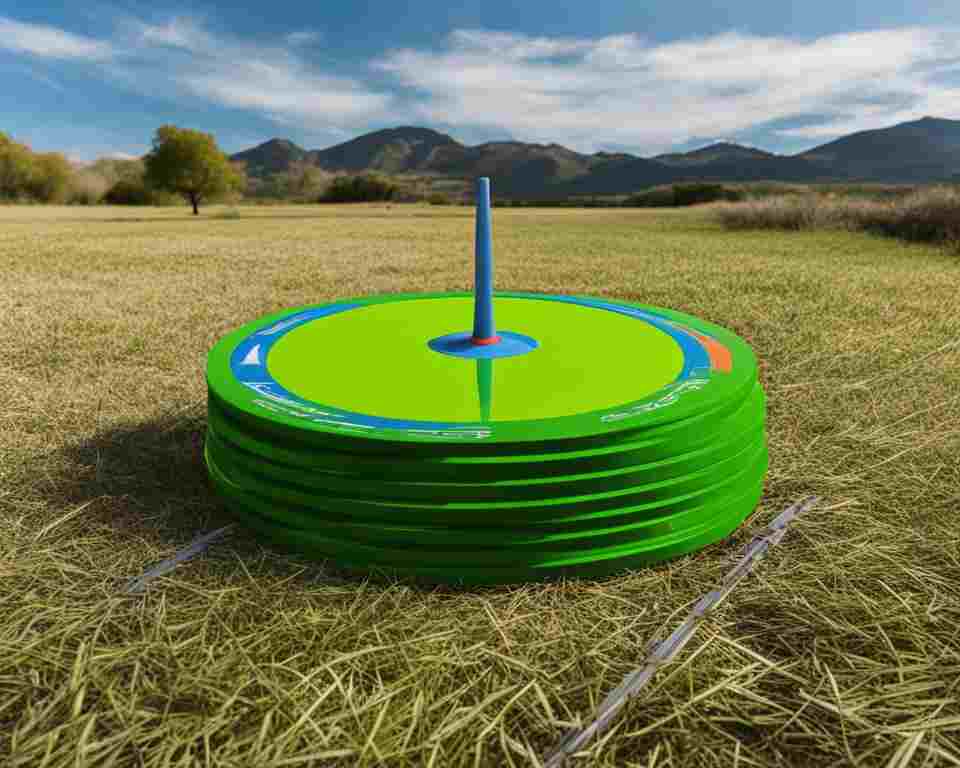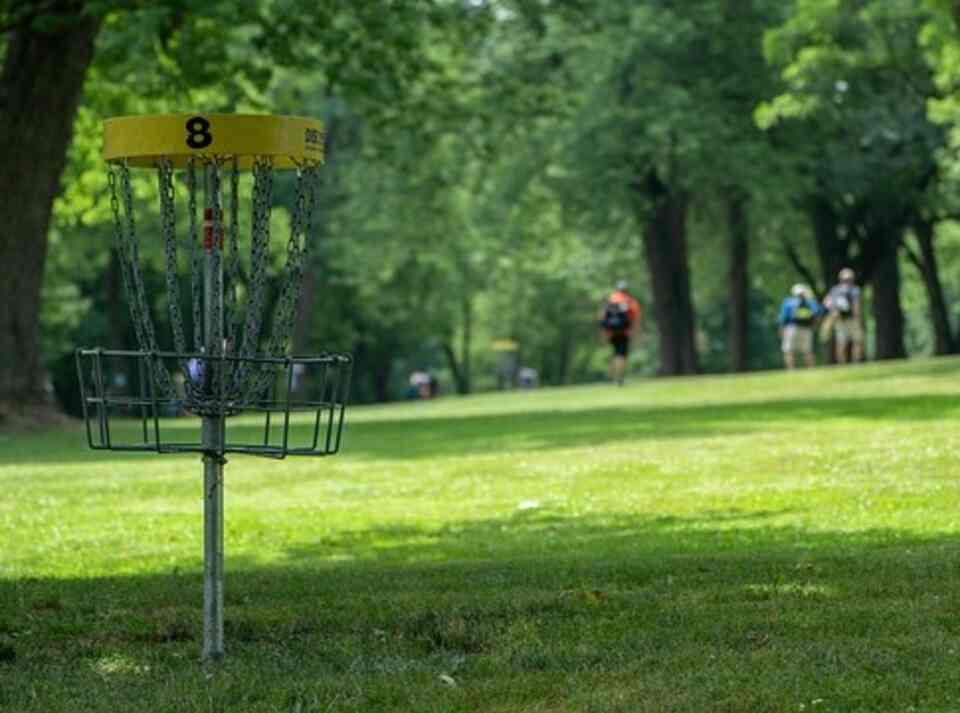Disc golf is a sport that involves throwing discs at targets, similar to traditional golf. If you’re new to the game, you may have come across the term “overstable” and wondered what it means. In this article, I will explain the definition of overstable in disc golf and why it’s important to understand this concept for your game.
Key Takeaways:
- Overstable discs tend to fade or turn left at the end of their flight.
- Experienced players and windy conditions often call for overstable discs.
- Understanding disc stability is crucial for selecting the right discs for your game.
- Flight ratings and factors like mold, rim width, and parting line height influence disc stability.
- Choosing between overstable and understable discs depends on the throwing scenario and player’s skill level.

What Does Overstable Mean in Disc Golf?
In disc golf, the term “overstable” refers to a disc’s tendency to resist turning or curving to the right (for right-handed backhand throws) during its flight. These discs have a predictable and consistent fade at the end, finishing to the left.
Overstable discs are favored in situations where players need to combat strong winds, execute a hard left turn around obstacles, or manage shots with a risk of turning too much to the right.
It’s important to note that disc stability is relative to the thrower’s arm speed and technique, and players often carry a variety of discs with different stability ratings to suit various shot shapes and course conditions.
What is Disc Stability in Disc Golf?
Disc stability in disc golf refers to a disc’s tendency to fly straight, fade left, or turn right after it is released from a player’s hand. The stability of a disc is influenced by the air pressure above and below it, which creates forces that affect its flight characteristics. Disc stability is indicated by the flight ratings stamped on a disc, including Speed, Glide, Turn, and Fade. These ratings provide valuable information about a disc’s stability and can help players visualize how a disc will fly before they even throw it.
Disc stability is a crucial factor to consider when choosing discs for your game. It determines how the disc will behave during different stages of its flight, such as initial release, mid-flight, and the end of the flight. Understanding the stability of a disc can help players select the right discs for their throwing style and the desired flight path.
Table: Overview of Flight Ratings
| Flight Rating | Description |
|---|---|
| Speed | Indicates the rate at which the disc flies through the air. |
| Glide | Describes the disc’s ability to maintain loft during flight. |
| Turn | Refers to the disc’s tendency to turn to the right at the beginning of the flight (for RHBH throws). |
| Fade | Represents the disc’s tendency to fade to the left at the end of the flight. |
What Do Flight Ratings Mean in Disc Golf?
Flight ratings are an important aspect of understanding the flight characteristics of a disc in disc golf. These ratings are displayed as four numbers on the disc and provide valuable information about how the disc will fly when thrown. The flight ratings consist of Speed, Glide, Turn, and Fade, respectively.
The Speed rating indicates how fast the disc will fly through the air when thrown with enough power. A higher Speed rating generally means the disc requires more arm speed and technique to achieve its desired flight path. The Glide rating represents the disc’s ability to maintain loft during flight. A higher Glide rating means the disc will stay in the air longer and generally have more distance potential.
The Turn rating is a measure of the disc’s tendency to turn or curve to the right during its initial flight (for right-handed backhand throws). A negative Turn rating indicates the disc will have more turn, while a positive rating means the disc will resist turning. Finally, the Fade rating indicates the disc’s tendency to fade or curve to the left at the end of its flight. A higher Fade rating means the disc will have a stronger left finish.
Understanding these flight ratings can help players choose discs that align with their throwing style and desired flight paths. For example, a player looking for a disc that will turn to the right (for RHBH throws) can search for discs with a higher negative Turn rating. Similarly, players seeking discs that exhibit a strong left finish can look for discs with a higher Fade rating. By analyzing the flight ratings, players can gain insights into how a disc will behave in flight and make informed decisions when selecting discs for their game.
What Factors Influence Disc Stability?
Disc stability in disc golf is influenced by several factors that affect the flight characteristics of a disc. Understanding these factors can help players select discs with the desired stability for their game. Let’s explore the key variables that contribute to disc stability:
- The disc’s mold: The mold of a disc determines how air flows over and under the disc, directly impacting its stability. Different molds are designed to have varying degrees of stability, from understable to overstable.
- The width of the disc’s rim: The width of a disc’s rim plays a significant role in stability. Discs with wider rims tend to have more stability, making them suitable for advanced players and high-speed throws.
- The parting line height (PLH): The parting line height refers to the separation line on the nose of the disc. A higher PLH indicates less turnover and greater stability, while a lower PLH results in more turnover and less stability.
- The type of plastic: The type of plastic used to make the disc can also impact its stability. Different types of plastic have different flexibilities and durability, which can affect the overall flight characteristics of the disc.
Table: Factors Influencing Disc Stability
| Factors | Impact on Stability |
|---|---|
| Disc Mold | Different molds have varying degrees of stability, from understable to overstable. |
| Rim Width | Wider rims generally result in more stability, while narrower rims tend to be more understable. |
| Parting Line Height (PLH) | A higher PLH indicates greater stability, while a lower PLH results in less stability. |
| Type of Plastic | Different types of plastic can affect the overall flight characteristics of the disc. |
By considering these factors and experimenting with different discs, players can find the perfect balance of stability that suits their throwing style, skill level, and course conditions. It’s important to note that each player may have their own preferences, so it’s always a good idea to try out different discs and see how they perform in various situations.
Next, we will delve into the impact of rim width on disc stability and how it can affect a disc’s flight characteristics.
How Does Rim Width Affect Disc Stability?
The width of a disc’s rim plays a significant role in its stability. Discs with wider rims tend to have more stability, making them suitable for experienced players and high-speed throws. These discs require more arm speed and technique to achieve their desired flight paths. On the other hand, discs with narrower rims are generally more understable and suitable for beginners or players with slower arm speeds. The rim width directly affects the weight distribution of the disc, influencing its stability and flight characteristics.
To better understand the impact of rim width on disc stability, let’s take a look at the following table:
| Rim Width (millimeters) | Stability |
|---|---|
| Wider than average | More stable |
| Average width | Moderate stability |
| Narrower than average | Less stable |
As you can see, discs with wider rim widths tend to have higher stability, providing more resistance against turn and fade. These discs are commonly used for power shots and in windy conditions where control and stability are crucial. On the other hand, discs with narrower rim widths are generally easier to throw and offer less resistance to turn, making them more beginner-friendly.
Keep in mind that rim width is just one factor that influences disc stability. Other factors such as disc mold, parting line height (PLH), and the type of plastic used also play significant roles in determining a disc’s stability. It’s important to consider all these factors and their interactions when selecting discs that suit your throwing style and desired flight paths.
How Does Parting Line Height Impact Disc Stability?
Parting Line Height (PLH) plays a significant role in determining a disc’s stability and flight characteristics. The PLH refers to the separation line on the nose of the disc created during the manufacturing process. A higher PLH indicates less shrinkage and results in greater stability, while a lower PLH indicates more shrinkage and makes the disc more understable. Understanding the impact of PLH allows players to choose discs that align with their throwing style and desired flight characteristics.
When the PLH is high, the disc maintains its original shape better and experiences less deformation during flight. This greater stability allows the disc to resist turning over and prevents excessive fade at the end of the flight. Discs with high PLH are often preferred by experienced players who want reliable and consistent flight paths. These discs are especially useful in windy conditions when the stability helps them combat the effects of crosswinds.
On the other hand, discs with a low PLH have more deformation during flight, which makes them more understable. These discs tend to turn over easier and have less fade at the end of the flight. They are ideal for beginners or players with slower arm speeds who may struggle to generate enough power for stable or overstable discs. The lower PLH allows these discs to fly straighter or turn to the right (for right-handed backhand throws) without excessive fade, providing more forgiving flight paths.
Impact of PLH on Disc Stability – A Comparative Overview
| High PLH | Low PLH |
|---|---|
| Greater stability | More understable |
| Resists turning over | Turns over easily |
| Less fade | Less fade |
| Ideal for experienced players | Ideal for beginners and slower arm speeds |
In conclusion, the parting line height (PLH) of a disc directly influences its stability and flight characteristics. Higher PLH provides greater stability, resisting turning over and offering reliable flight paths. Lower PLH results in more understable discs, making them forgiving and suitable for beginners or players with slower arm speeds. Understanding the impact of PLH allows players to choose discs that match their throwing style and provide the desired flight characteristics on the disc golf course.

How Does Beating in Affect Disc Stability?
Beating in a disc is a natural process that occurs over time as the disc collides with various objects during gameplay, such as trees or rocks. This repeated impact causes the disc’s plastic to gradually change its shape and texture, resulting in alterations to its flight characteristics and stability. When a disc is beaten in, it becomes more understable, meaning that it has a higher propensity to turn right (for RHBH throws) and has less fade at the end of its flight.
The beating in process primarily affects the parting line height (PLH) of the disc. As the disc is hit, the PLH can shift, leading to changes in the disc’s stability. A higher PLH provides more stability and resistance to turnover, while a lower PLH makes the disc more prone to turning. This adjustment to the PLH, accompanied by the plastic breaking in, can significantly impact the disc’s flight path and make it more maneuverable for specific shot shapes and skill levels.
Impact of Beating In on Disc Stability: A Comparative Analysis
| Before Beating In | After Beating In | |
|---|---|---|
| Stability | Higher Stability | Lower Stability |
| Turn | Less Turn | More Turn |
| Fade | More Fade | Less Fade |
| Flight Path | Straighter with reliable fade | More turnover with reduced fade |
It’s important to note that the effects of beating in on disc stability can vary depending on factors such as the specific mold, plastic type, and the severity and frequency of impacts. Additionally, the preferences of individual players play a significant role in determining the level of beating in that is desirable. Some players may prefer discs that are slightly beaten in for enhanced maneuverability, while others may prefer discs with minimal beating in for consistent flight paths.
Ultimately, the process of beating in a disc can provide players with unique flight characteristics and versatility on the course. However, it’s crucial to keep in mind that beating in a disc is not a guarantee of improved performance or stability. Players should experiment with different levels of beating in and seek a balance that complements their throwing style and desired flight paths.
Characteristics of Understable Discs
Understable discs are a popular choice in disc golf, especially for players who are just starting out or have a lower arm speed. These discs have unique flight characteristics that can greatly benefit beginners. One key characteristic of understable discs is their tendency to turn to the right during flight when thrown with a right-handed backhand (RHBH) throw. This turning flight path can help beginners achieve longer distances and straighter shots, even with less power and accuracy.
One notable feature of understable discs is their lighter weight compared to more stable discs. The lighter weight allows for easier control, making them forgiving for players who are still developing their throwing technique. Additionally, understable discs typically have higher glide ratings, which means they can stay in the air longer and generate more distance with less effort. This extra glide can be advantageous for beginners looking to maximize their throw without exerting excessive force.
“Understable discs have become a staple in my bag as a beginner disc golfer. They help me achieve straighter shots and increase my distance even when my form is not perfect. It’s incredible how forgiving they are, and I highly recommend them to anyone starting their disc golf journey.” – Disc Golf Enthusiast
It’s important to note that understable discs are not recommended for use in windy conditions. Their instability can be amplified by strong winds, causing them to become unpredictable and difficult to control. When faced with windy conditions, it is generally advisable to switch to more stable or overstable discs, which are better equipped to handle the challenging weather conditions and maintain their flight patterns.

| Disc | Speed | Glide | Turn | Fade |
|---|---|---|---|---|
| Disc X | 7 | 5 | -2 | 1 |
| Disc Y | 6 | 6 | -3 | 1 |
| Disc Z | 8 | 4 | -1 | 1 |
In summary, understable discs offer unique flight characteristics that make them ideal for beginners or players with lower arm speeds. Their tendency to turn to the right during flight can help beginners achieve longer distances and straighter shots with less power and accuracy. However, they are not recommended for use in windy conditions due to their instability. With their lighter weight and higher glide ratings, understable discs can be valuable tools for beginners looking to improve their disc golf game.
Characteristics of Overstable Discs
Overstable discs are a crucial part of any disc golfer’s arsenal, offering unique flight characteristics that provide excellent control and stability. When thrown with a right-handed backhand (RHBH) throw, overstable discs have a higher tendency to fade to the left at the end of their flight. This fade allows players to execute shots that require a hard left finish, making overstable discs ideal for certain situations on the course.
Experienced players often favor overstable discs due to their ability to fight against strong winds. These discs maintain their flight pattern even in challenging weather conditions, ensuring predictable and reliable performance. The resistance to turn and the strong fading characteristics of overstable discs make them suitable for shots that require consistency, accuracy, and control.
To achieve the optimum flight and stability with overstable discs, players need to generate more arm speed and apply proper throwing techniques. Due to their inherently stable nature, overstable discs can be challenging for beginners or players with slower arm speeds. However, as players develop their skills and increase their throwing power, they can harness the advantages of overstable discs for various shots and strategies on the course.
Flight Characteristics of Overstable Discs
| Flight Rating | Description |
|---|---|
| Speed | Usually lower speed for overstable discs, requiring more arm speed to achieve the desired flight. |
| Glide | Typically lower glide ratings, resulting in less distance potential compared to understable discs. |
| Turn | Minimal or negative turn rating, indicating resistance to turning right during flight (RHBH throw). |
| Fade | High fade rating, causing the disc to fade strongly to the left at the end of its flight. |
Understanding the flight ratings of overstable discs is essential for selecting the right disc for specific shots and desired flight paths. The flight ratings provide insights into the disc’s stability, speed, distance potential, and fading characteristics. By considering these ratings, players can make informed decisions and choose overstable discs that suit their throwing style and the strategic requirements of each hole on the course.
When to Use Overstable and Understable Discs
When it comes to choosing discs for your disc golf game, understanding when to use overstable and understable discs is crucial. The decision should be based on various factors, including your skill level, throwing style, and the specific conditions on the course.
Choosing Overstable Discs: Overstable discs are typically preferred by advanced or intermediate players with considerable power. These discs have a higher tendency to fade to the left at the end of their flight when thrown with a right-handed backhand (RHBH) throw. They offer reliable flight paths and extra stability, making them ideal for shots that require a hard left finish. Additionally, overstable discs are commonly used in windy conditions, as they can fight against the wind and maintain their flight pattern. However, they require more arm speed and technique to achieve optimum performance and stability.
Choosing Understable Discs: Understable discs are generally more beginner-friendly and forgiving. They have a lighter weight and a tendency to turn to the right during their flight when thrown with a RHBH throw. Understable discs are suitable for beginners or players with slower arm speeds, as they require less power and release accuracy to achieve desired flight paths. These discs offer a straighter flight path for longer distances and can help beginners develop correct throwing mechanics. It’s important to note that understable discs are not recommended for use in windy conditions, as their instability can be amplified by strong winds.
By knowing when to use overstable and understable discs, you can make informed decisions that maximize your distance and accuracy on the course.

Difference between Overstable and Understable Discs:
| Aspect | Overstable Discs | Understable Discs |
|---|---|---|
| Flight Path | Fades to the left (RHBH) | Turns to the right (RHBH) |
| Throwing Style | Requires more arm speed and technique | Requires less power and release accuracy |
| Skill Level | Advanced or intermediate | Beginner or slower arm speeds |
| Wind Conditions | Suitable for windy conditions | Not recommended for windy conditions |
| Flight Stability | Extra stability and control | More forgiving and versatile |
Comparing the characteristics of overstable and understable discs can help you decide which type of disc is best suited for your specific needs and playing style.
Best Disc Stability for Beginners
When it comes to disc stability for beginners in disc golf, understable discs are generally the recommended option. These discs are specifically designed to be easier to throw, making them more forgiving for players with lower arm speeds. With their tendency to turn to the right during flight (for RHBH throws), understable discs offer a straighter flight path and can help beginners achieve longer distances with less power and release accuracy.
Starting with understable discs allows beginners to focus on developing correct throwing mechanics and gaining confidence without being overwhelmed by the more challenging stability of overstable discs. The higher glide ratings of understable discs also help generate more distance with less effort, making them an excellent choice for beginners looking to improve their throwing skills.
As beginners gain experience and increase their arm speed, they can gradually transition to using more stable and overstable discs. This progression will allow them to explore different flight paths, adapt to various course conditions, and improve their overall performance on the course. It’s essential for beginners to understand and experiment with disc stability to find the right discs that suit their throwing style and desired flight characteristics.
| Disc Type | Flight Characteristics |
|---|---|
| Understable Discs | – Tendency to turn to the right (for RHBH throws) – Easier to throw for beginners – Straighter flight path – Higher glide ratings for more distance with less effort |
| Stable/Overstable Discs | – Tendency to fade to the left (for RHBH throws) – Preferred by experienced players – Suitable for windy conditions and controlled shots – Require more arm speed and technique |
Choose the right disc stability for beginners based on their throwing abilities, desired flight paths, and course conditions. Starting with understable discs provides a solid foundation for building skills and confidence, while gradually transitioning to more stable and overstable discs expands the range of shots and challenges that can be tackled on the disc golf course.
Conclusion
The importance of disc stability in disc golf cannot be overstated. Mastering disc flight is crucial for players who want to improve their performance and achieve desired flight paths. By understanding the concept of disc stability and its influence on a disc’s flight characteristics, players can make informed decisions when choosing their discs.
Whether it’s selecting an overstable disc that offers reliable flight paths and extra stability in windy conditions, or an understable disc that provides forgiveness and versatility for beginners, the right disc stability can significantly impact a player’s game.
Understanding flight ratings, factors influencing stability, and the characteristics of different discs allows players to make informed decisions and enhance their overall disc golf experience. By choosing the right discs with the appropriate stability, players can maximize their distance and accuracy on the course.
So, whether you’re a beginner just starting out or an experienced player looking to refine your game, mastering the concept of disc stability is essential for unlocking your full potential in disc golf.
FAQ
What does “overstable” mean in disc golf?
Overstable discs in disc golf refer to discs that have a tendency to fade or turn left at the end of their flight when thrown with a right-handed backhand (RHBH) throw. These discs are often referred to as “beefy” and are commonly used by more experienced players and in windy conditions.
What is disc stability in disc golf?
Disc stability in disc golf refers to a disc’s tendency to fly straight, fade left, or turn right after it is released from a player’s hand. The stability of a disc is influenced by the air pressure above and below it, which creates forces that affect its flight characteristics.
What do flight ratings mean in disc golf?
Flight ratings are four numbers stamped on a disc that describe its flight characteristics. The numbers represent Speed, Glide, Turn, and Fade, respectively. Understanding these flight ratings can help players choose discs that suit their throwing style and desired flight paths.
What factors influence disc stability?
Several factors can influence a disc’s stability in flight. These include the disc’s mold, the width of its rim, and the parting line height (PLH). The type of plastic used to make the disc can also impact its stability.
How does rim width affect disc stability?
The width of a disc’s rim plays a significant role in its stability. Discs with wider rims tend to have more stability, making them suitable for experienced players and high-speed throws. Discs with narrower rims are generally more understable and suitable for beginners or players with slower arm speeds.
How does parting line height impact disc stability?
The parting line height (PLH) of a disc refers to the separation line on the nose of the disc created during the manufacturing process. Higher PLH indicates less shrinkage and therefore less turnover, resulting in greater stability. Lower PLH indicates more shrinkage and turnover, making the disc more understable.
How does beating in affect disc stability?
Beating in a disc refers to the process of a disc becoming more understable over time due to hitting objects like trees. Beating in can make a disc more understable, making it turn more easily and have less fade. However, it’s important to note that beating in a disc is not a guarantee of improved performance and stability.
What are the characteristics of understable discs?
Understable discs are lighter in weight and have a tendency to turn to the right during their flight when thrown with a right-handed backhand (RHBH) throw. They are generally more beginner-friendly, offer a straighter flight path for longer distances, and can help beginners develop correct throwing mechanics.
What are the characteristics of overstable discs?
Overstable discs have a higher tendency to fade to the left at the end of their flight when thrown with a right-handed backhand (RHBH) throw. They are preferred by more experienced players and are commonly used in windy conditions due to their ability to fight against the wind and maintain their flight pattern.
When should I use overstable and understable discs?
The choice between overstable and understable discs depends on the throwing scenario and the player’s skill level. Overstable discs are typically used by more advanced or intermediate players with considerable power and in windy conditions. Understable discs are more versatile and forgiving, making them suitable for beginners and shots that require straighter flights or turning to the right without much fade.
What is the best disc stability for beginners?
For beginners with lower arm speeds, understable discs are generally the best option. These discs are easier to throw farther and require less power and release accuracy. They offer a straighter flight path for longer distances and can help beginners develop correct throwing mechanics.


